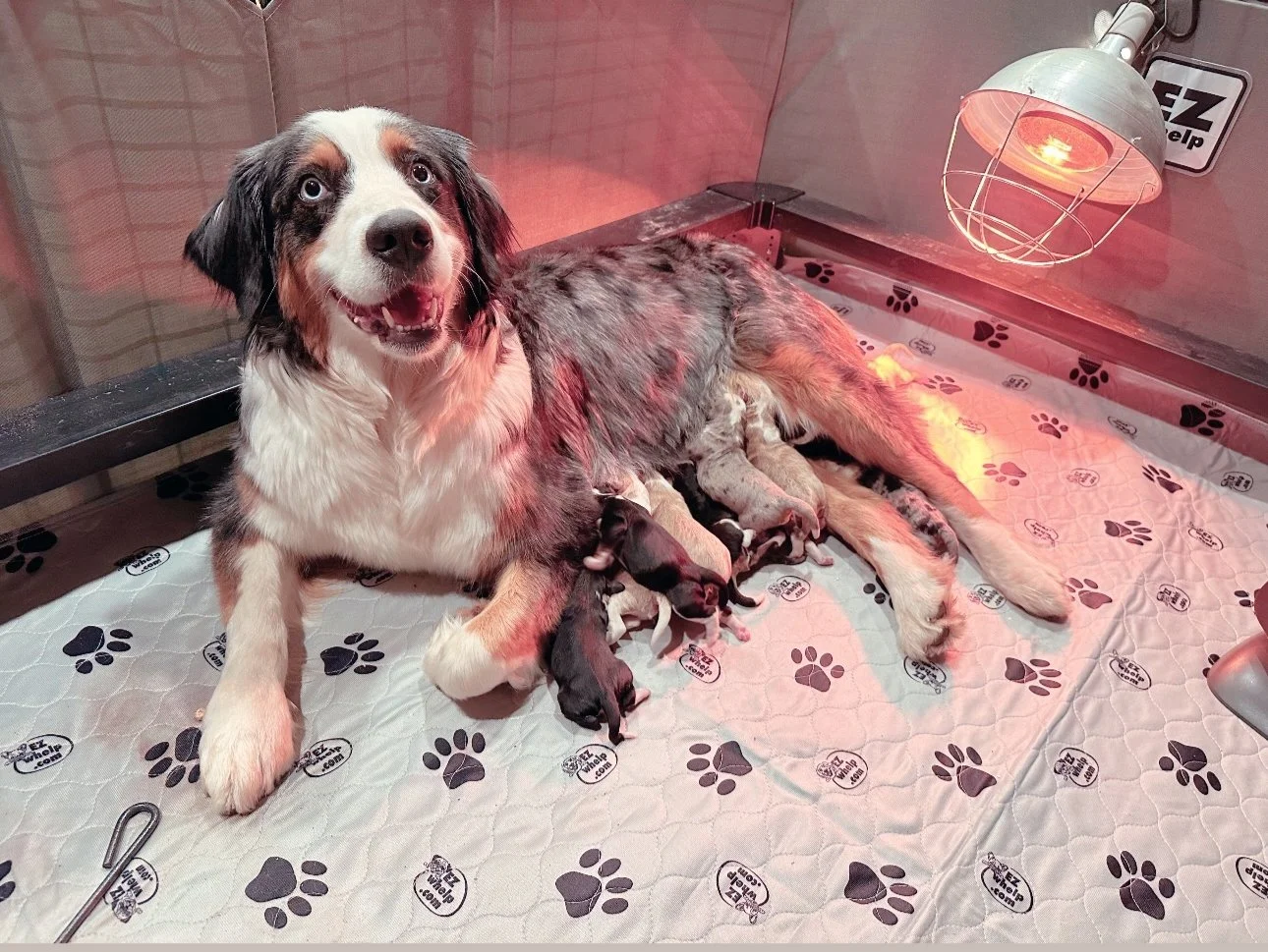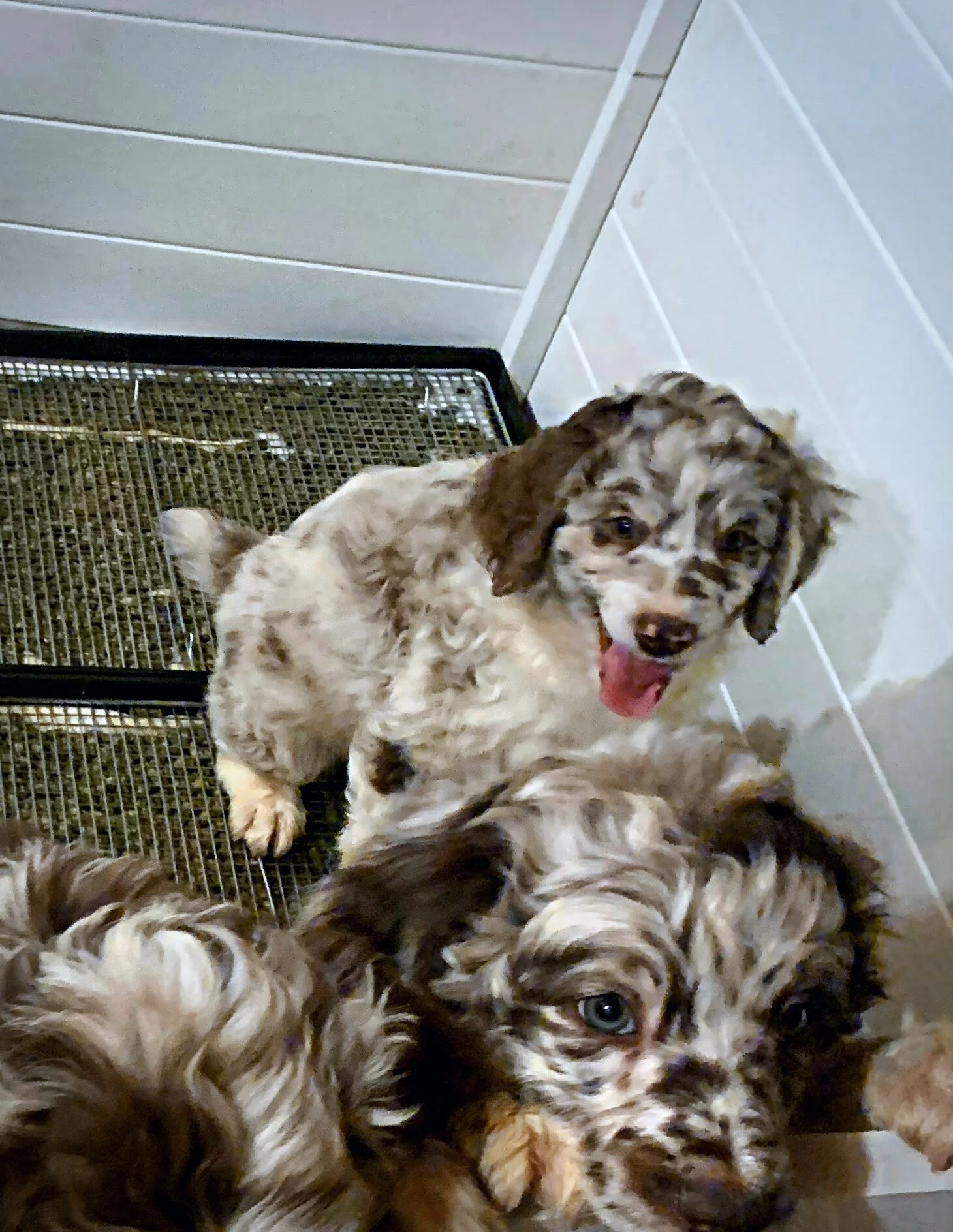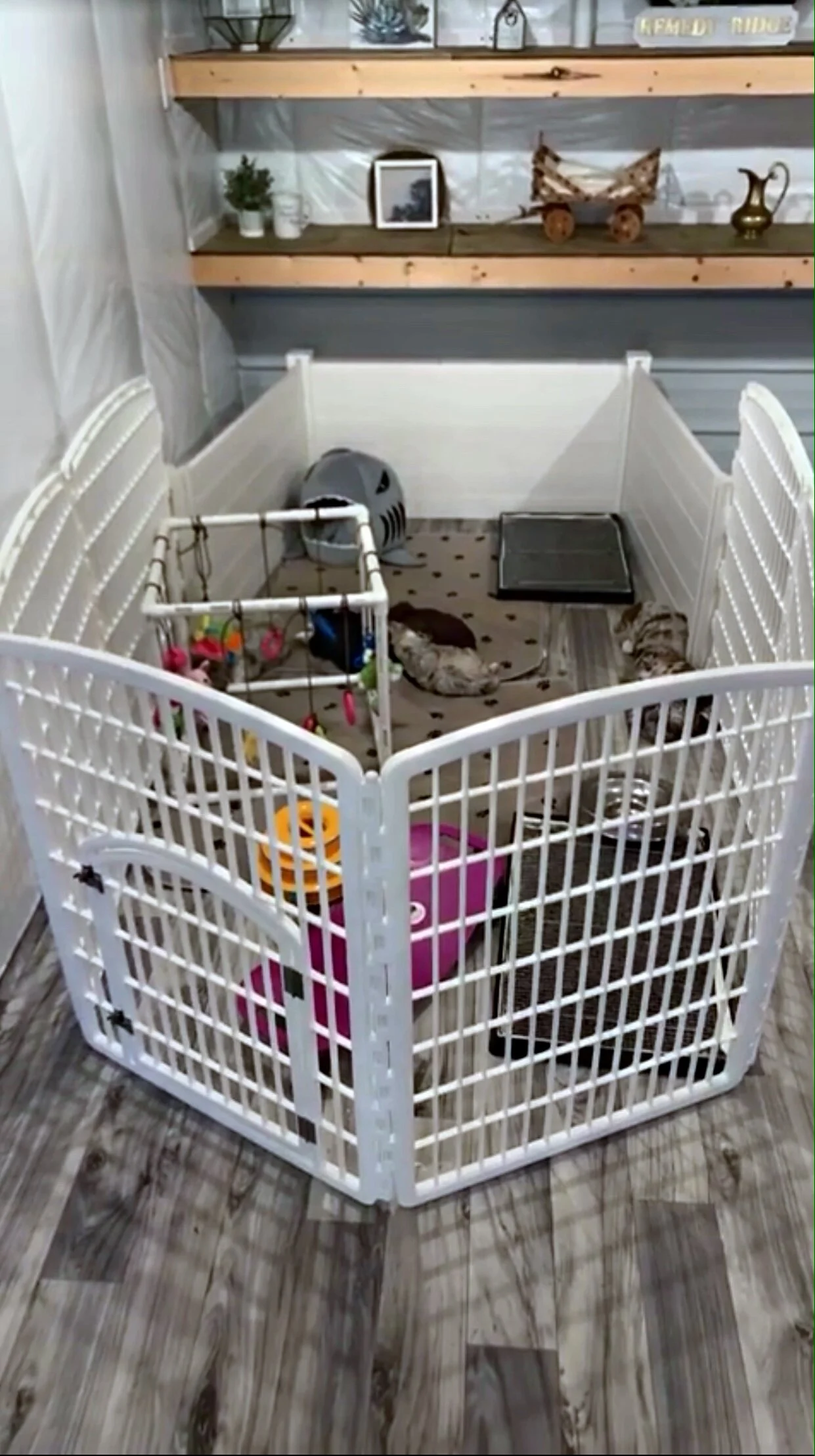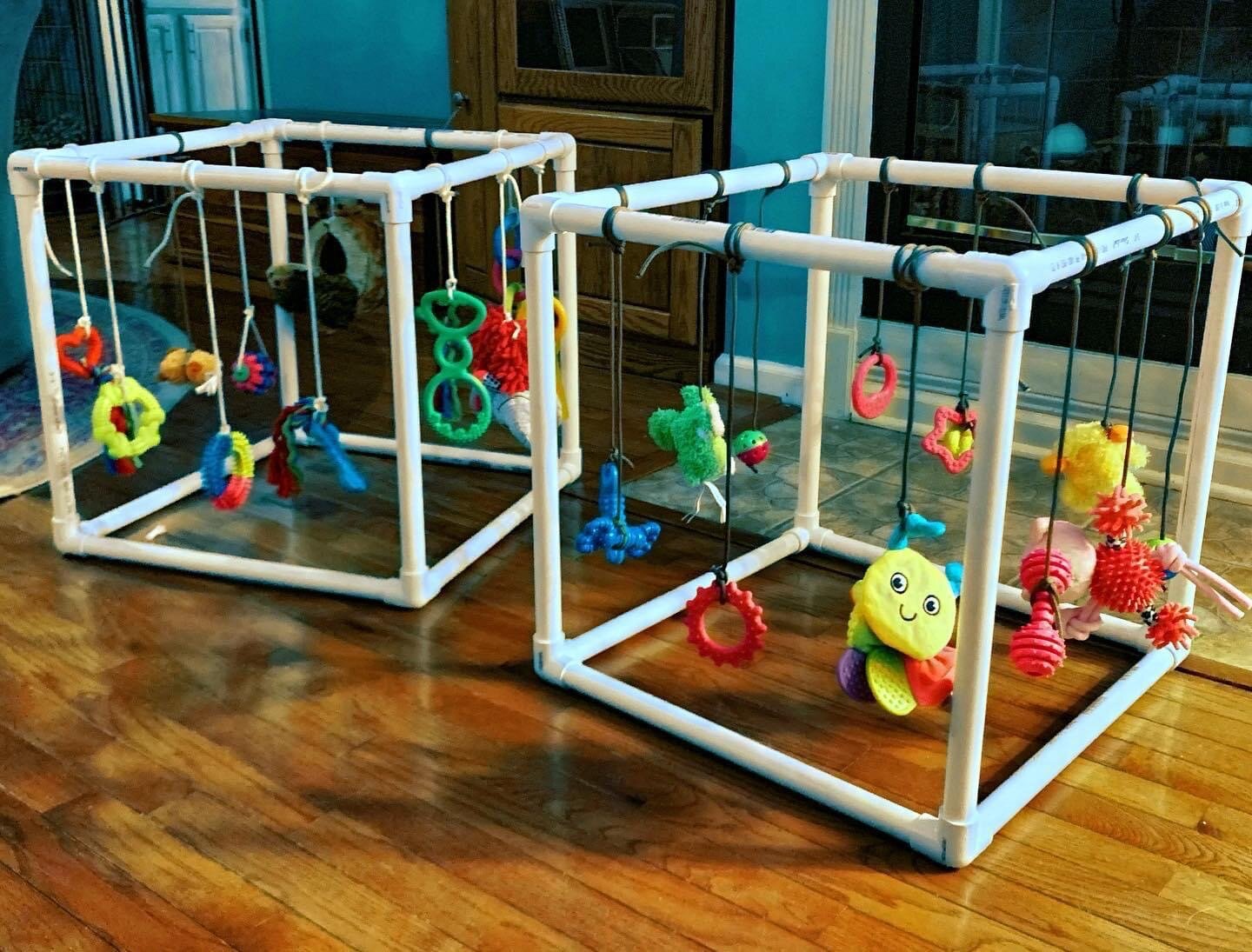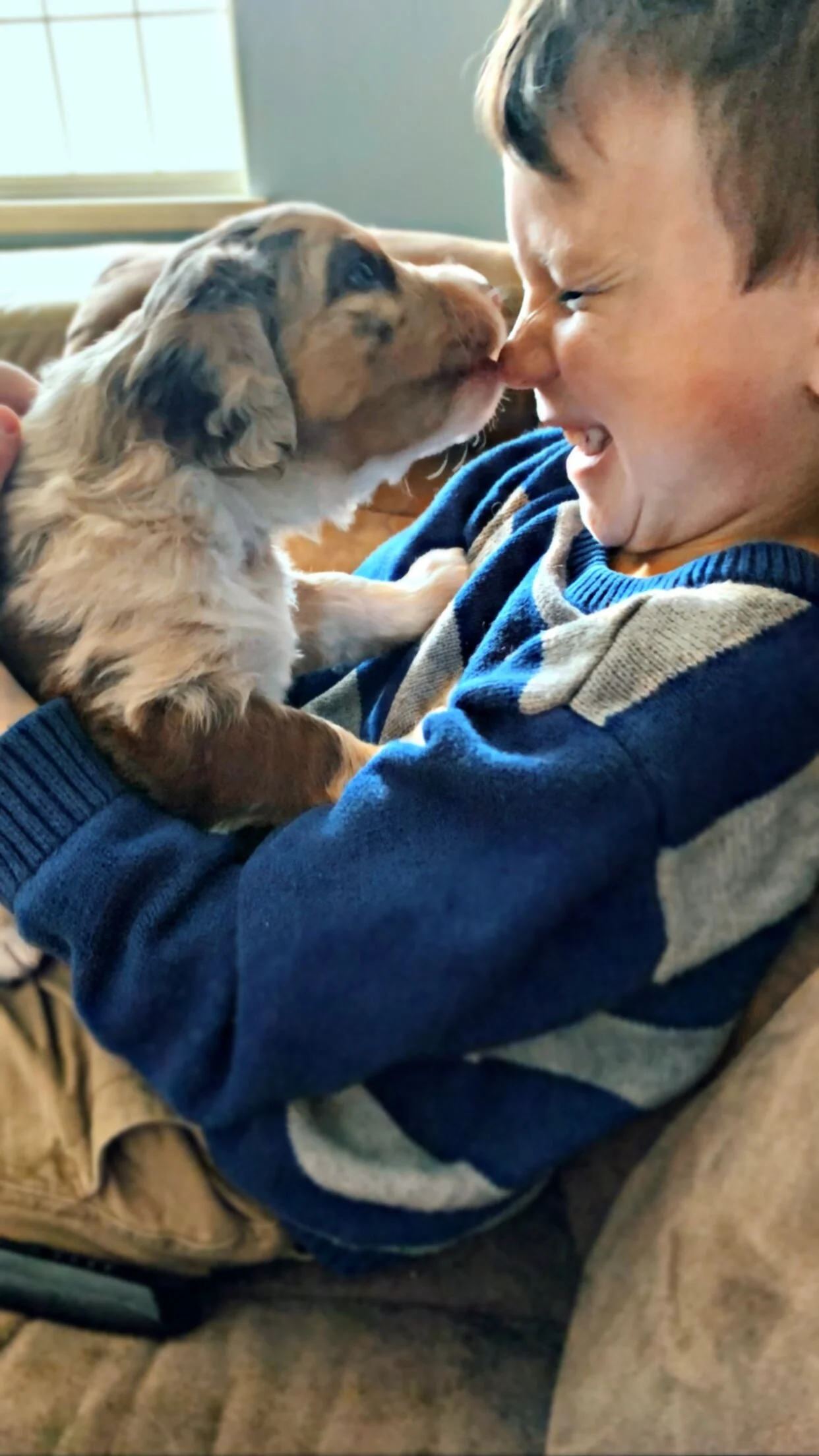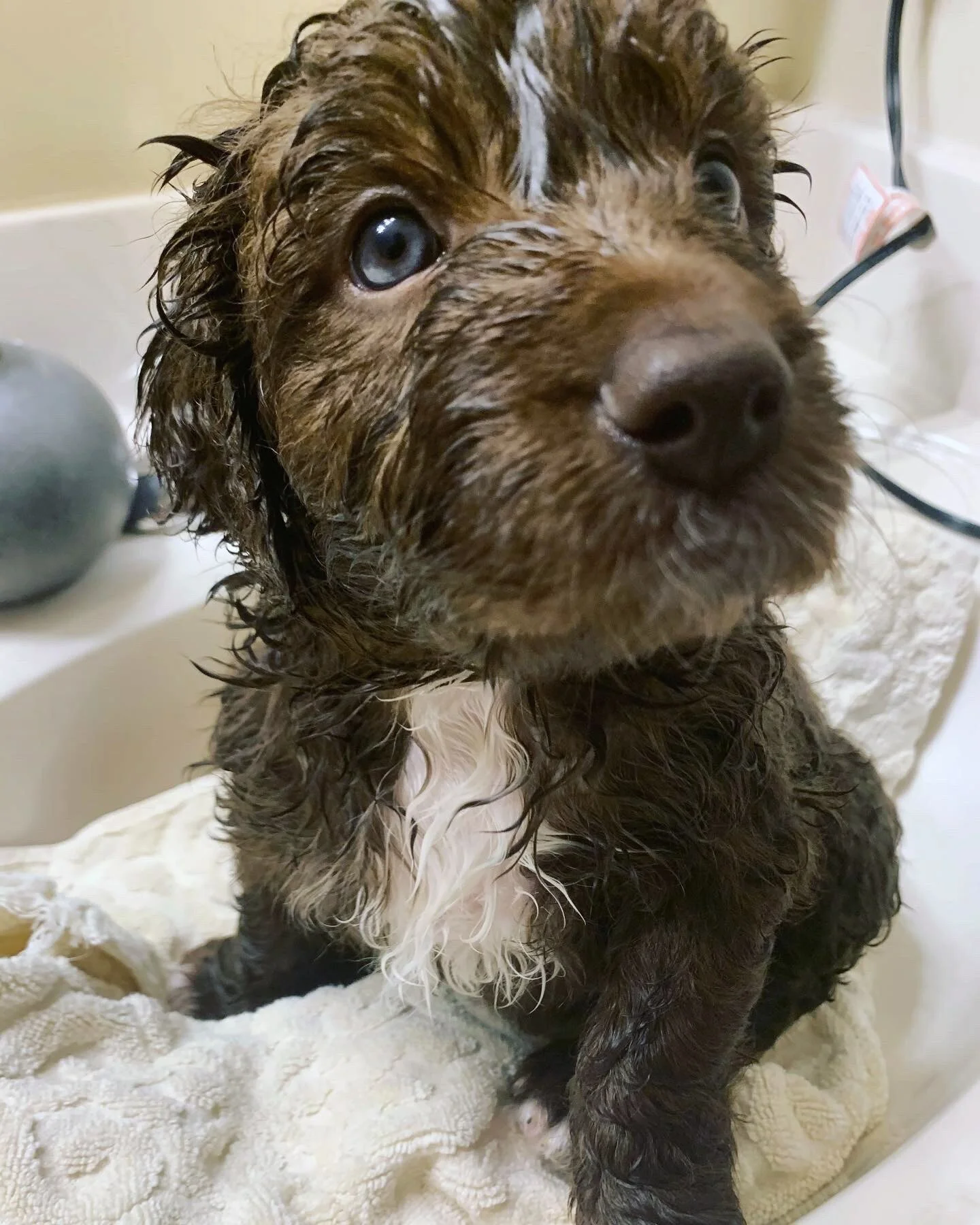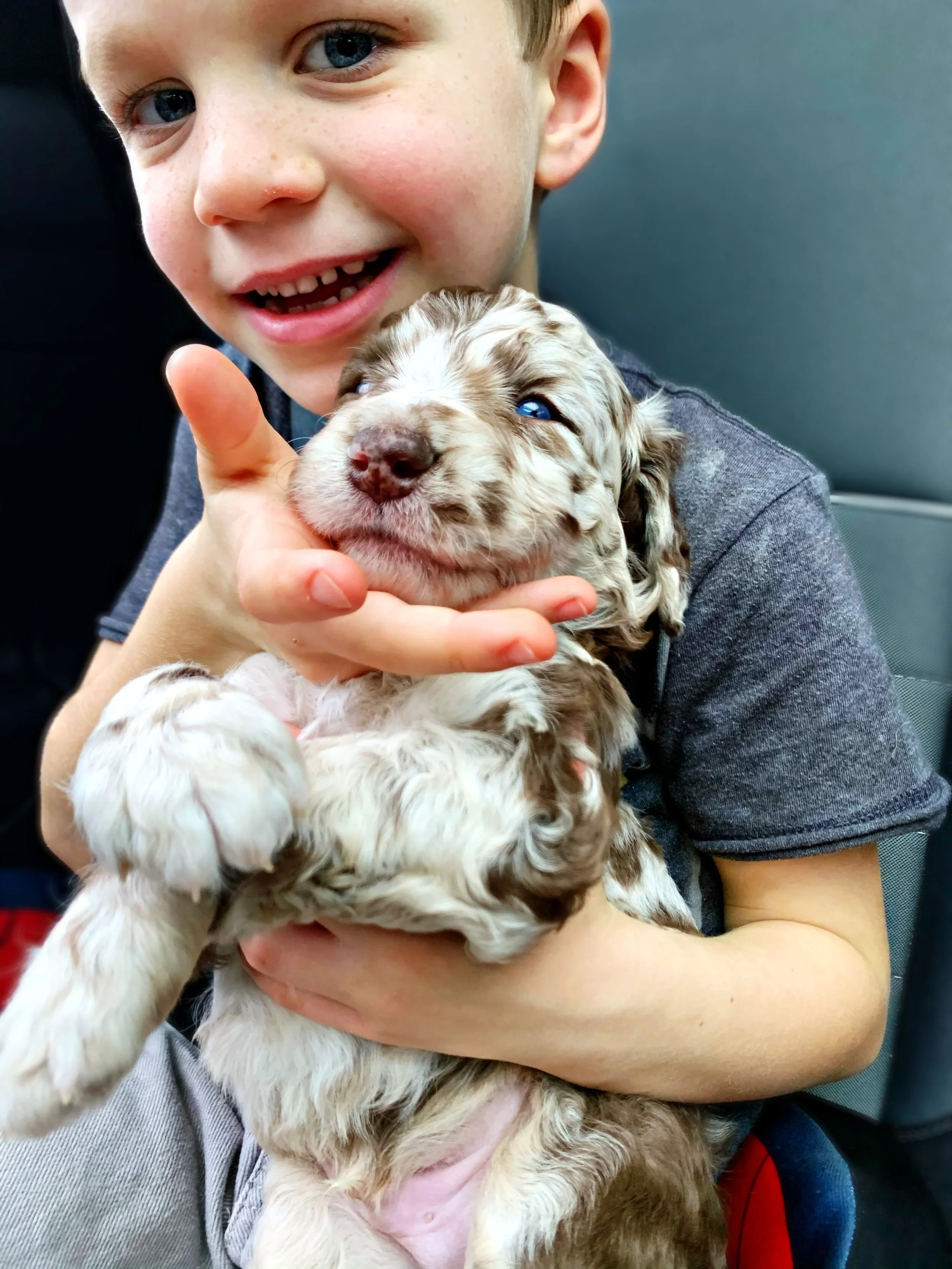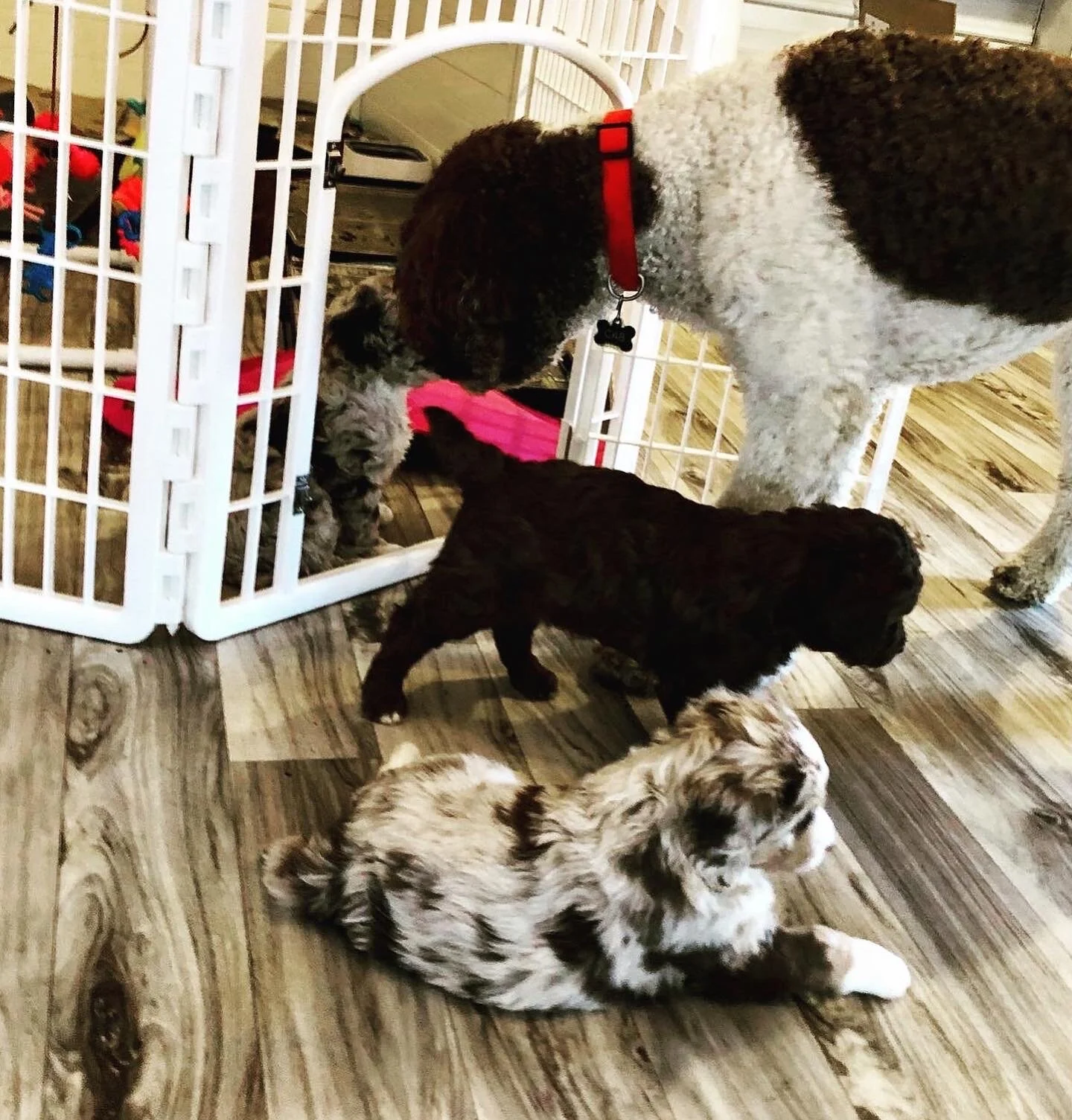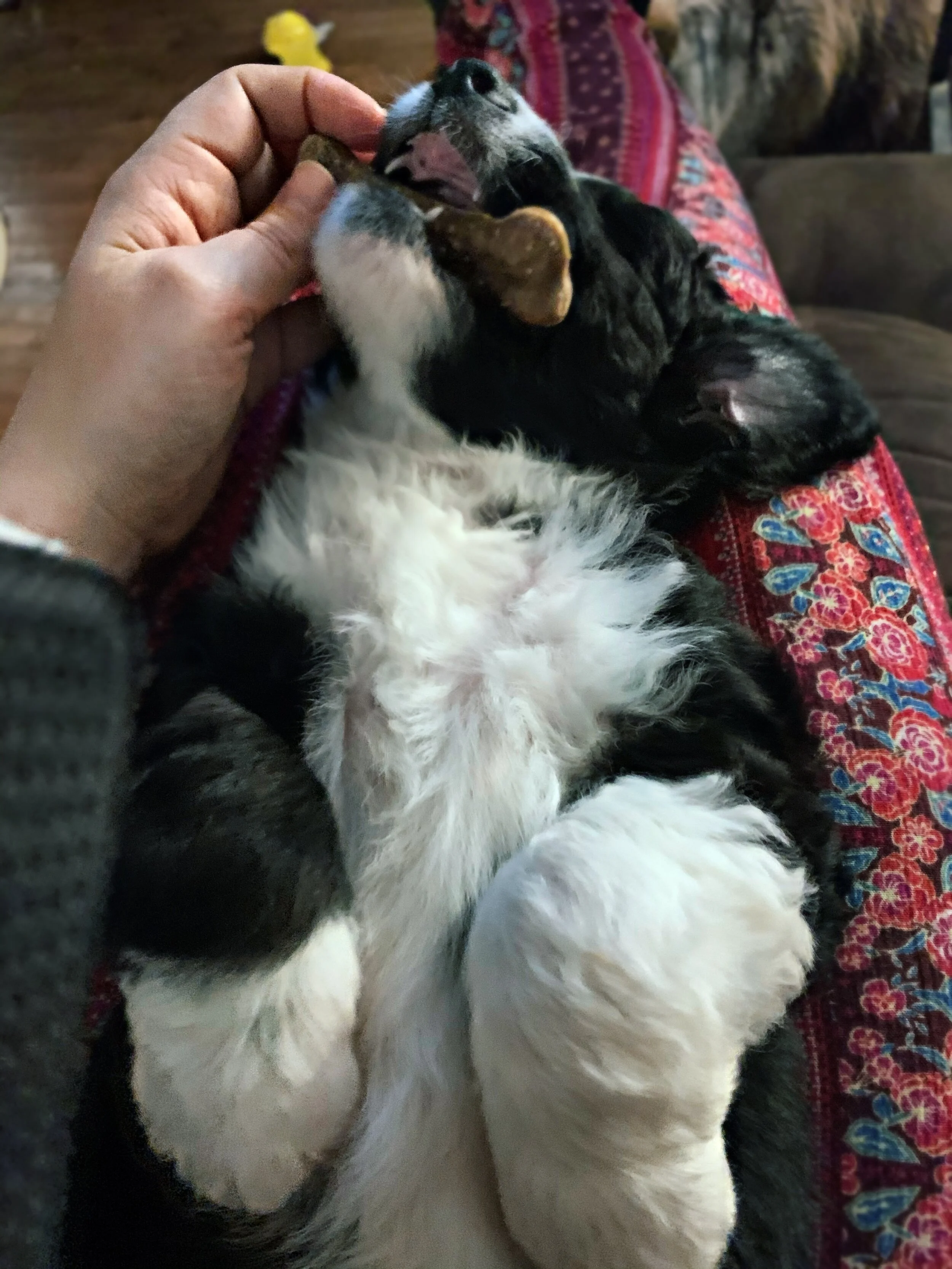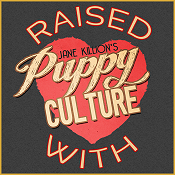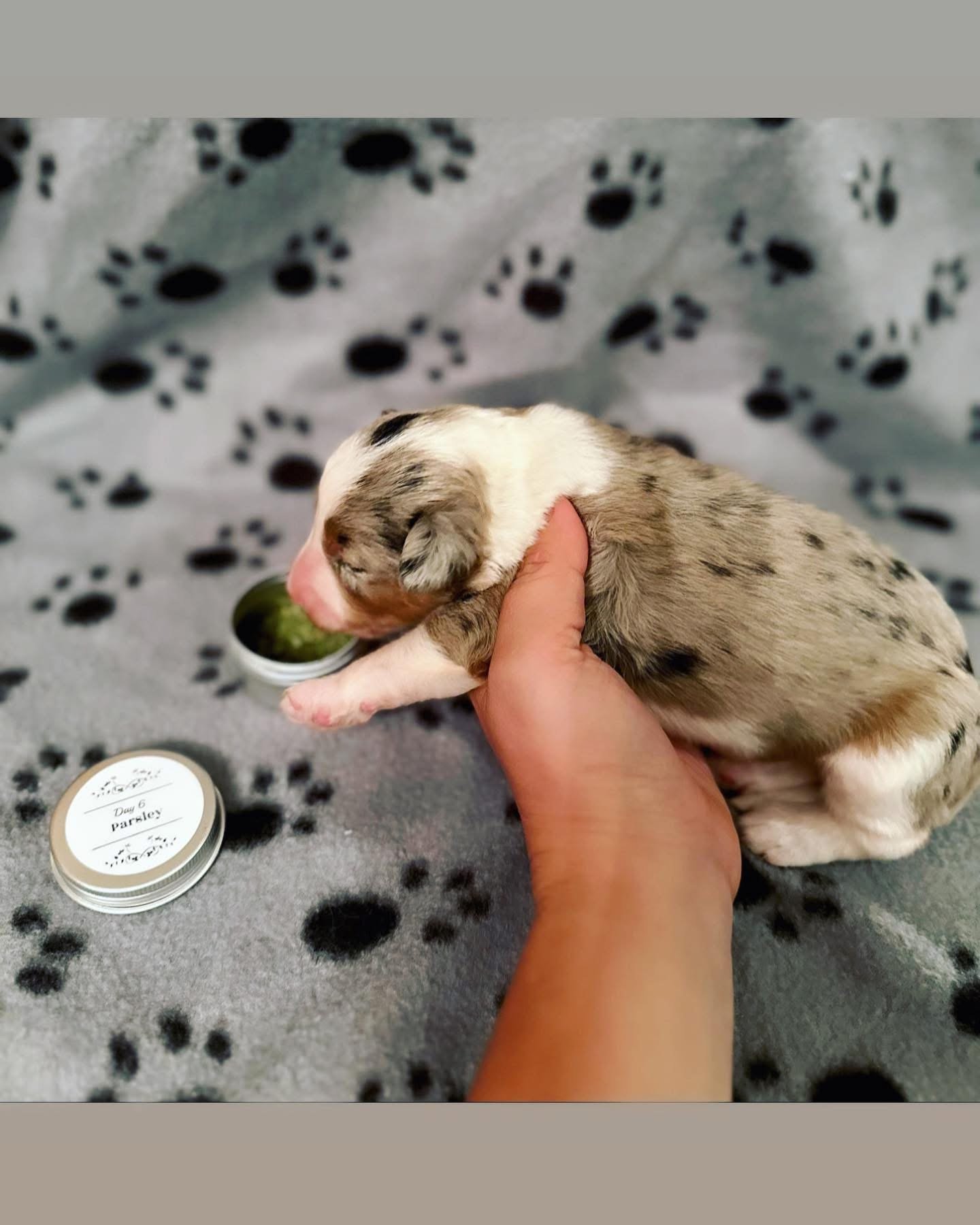We raise our puppies using top-quality whelping supplies and evidence-based practices to ensure their optimal physical and mental health. Every aspect of their care, from structured daily routines to enrichment activities, is carefully designed to promote healthy development. The first 8 weeks of life are critical not just for those aiming to train their puppy for therapy or service work but for every dog to grow into a confident, well-rounded companion. Research shows that proper socialization and desensitization during this time lead to improved heart health, stress resilience, and disease resistance. Our mission is to raise well-adjusted puppies who are ready to meet your unique goals, actively Healing Souls with Paws of Gold.
Good Whelping Dens:
We provide our dogs with high-quality, size-appropriate pet dens to ensure their comfort and security. For whelping mothers, the right-sized pen is essential for their psychological well-being, offering privacy and a sense of safety. A pen that feels too large or lacks privacy can make a mother feel vulnerable, as it is instinctual for dogs to seek secluded spaces while caring for their young.
During the first 3 weeks, we set up the whelping pen in our master bathroom, where the mother has the privacy she needs while remaining close to us for comfort and support. This setup allows us to closely monitor both her and the puppies during this critical period.
At 3 weeks, the puppies transition to an extended playpen in our living room, where they can begin adjusting to the sights, sounds, and activity of everyday life. By 5-6 weeks, the mother and puppies move to our state-of-the-art lofted barn facility. This spacious, insulated area is equipped with electricity, heating, air conditioning, an indoor extended play pen area with a grass patch and is connected to our outdoor extended play pen with a doggie door where our puppies learn to use and let themselves outside to go potty! It provides plenty of room for the puppies to explore, play, and continue their development in a safe and comfortable environment.
This progression ensures the mother and her puppies are cared for at every stage, setting them up for healthy, confident futures. Our barn facility is truly my favorite place to be, and it brings me so much joy to see our puppies thrive there as they need more developmentally to keep them stimulated and growing into their potentials.
Whelping Pads:
We use Durawhelp pads because they offer essential benefits that promote healthy development and safety for our puppies. Most importantly, these pads provide excellent traction, which is critical for preventing hip dysplasia. Research shows that puppies without proper traction during their first 8 weeks are at greater risk for this condition. Traction allows puppies to stabilize their feet while feeding and learning to stand, setting a strong foundation for mobility and growth.
These pads also prioritize safety by minimizing the chances of the mother accidentally burying a puppy beneath her or loose bedding. The secure Velcro design keeps the pads in place, reducing the risk of suffocation. Additionally, Durawhelp pads are highly absorbent, keeping puppies clean and dry, which is vital for their comfort and hygiene.
Puppy Rail:
Puppy rails are a safety mechanisms used by experienced breeders to ensure that the dam does not accidentally squish one her puppies against the whelping pen walls. The rails leave enough room for a small puppy to fit underneath but not enough for the dam.
Weighing Puppies:
It is crucial to keep track of puppy weights to make sure they are meeting size and growth standards. This ensures we notice if a puppy is failing to thrive and that puppies are getting enough milk. If not we will step in and make sure the puppy gets extra feeding time with mom and if that does not work we will begin to supplement. Puppies are weighed daily the first week and then once a week after that.
Litter Box Training:
All of our puppies will be introduced to a litter box. We use litter boxes to teach the puppies that it is best to go in one place to potty and that place is not near your sleeping area, play area or eating area. We fill each litter box with organic food grade alfalfa pellets in case they are ingested. We learned how to litter train puppies by investing in the“Puppy Culture” training series. By following their steps, puppies can be completely litter trained in just two days! This teaches puppies that going potty is for designated areas making outdoor potty training so much easier on you.
Food:
We proudly feed our puppies Pawtree’s Whitefish and Brown Rice Recipe, a premium, nutrient-rich formula designed to support their growth and overall health. This recipe features real whitefish as the first ingredient, providing high-quality protein essential for muscle development.
The inclusion of brown rice and pearled barley offers healthy grains for energy, while a blend of fruits and vegetables—such as apples, blueberries, cranberries, pumpkin, and spinach—supplies vital antioxidants and nutrients.
Developed by veterinarians and animal nutrition experts, this holistic recipe is free from corn, wheat, and soy, making it gentle on sensitive stomachs and promoting optimal digestion. Its natural ingredients and added probiotics support a balanced diet, ensuring your puppy receives comprehensive nutrition during these critical developmental stages.
Pawtree’s carefully crafted recipe is free from corn, wheat, and soy, making it gentle on sensitive stomachs while promoting optimal digestion. Its natural ingredients and probiotics support a balanced diet, ensuring your puppy gets everything they need to thrive during these critical developmental stages.
As proud affiliates of Pawtree, you can support your new puppy’s health while shopping conveniently through our exclusive affiliate link. Choosing Pawtree not only sets your puppy up for success but also helps support our program. As a thank you, we offer our customer’s an extra two years on their 3 year health guarantee. This is a no brainerd for us, as proper nutrition ensures a healthy dog and his longevity.
We start puppies on this food at 5 weeks old pureed with Organic Goats Milk. We slowly transition puppies off the Goats milk and by 7 weeks this is 100% their food source in addition to extra probiotics and a healthy bone and join supplement we add to their food (which we recommend you continue) By 8 weeks old they will be ready to continue their solid food diet with you. We will send you home with a three-day sample of this food and highly recommend it.
Activity Center:
The Activity Center is opened up to the puppies at 4 weeks old. The activity center extends from the whelping pen and contains a variety of toys with different textures. We also hang toys from PVC piping to give puppies more of a dynamic experience. We rotate toys out so they never get bored (which we encourage you to do at home). This stimulation helps desensitize puppies and keeps their growing brains healthy and happy. They learn healthy play in the activity center which prompts socialization.
Socialization:
With a background in psychology & a masters in social work, I fully understand the importance of socialization for not just humans, but dogs too. Just like humans, animals also need to be appropriately socialized in order to thrive in the future. We expose our puppies to as many other people and animals as possible with the understanding that if these puppies are not well adjusted to their current surroundings they will not adjust well to yours. WE create healthy and safe experiences for the puppies understanding that just ONE highly adverse experience can lead to the puppy being fearful for life. That is why it is SO important that you protect your dog from these experiences for the first few years of life if your goal is to be able to have a confident/non aggressive dog. With that being said, sheltering your dog from other people and other animals can also have adverse effects. Exposing your dog to safe people and pets you KNOW are friendly is the best thing you can do. Proper socialization, coupled with various desensitization techniques sets these puppies up for success, their genetics (nature) can only take them so far, you have to give them the nurture they need to grow into healthy minded adults. We begin all of that here for you!
Desensitization:
We do a lot of different things to desensitize the puppies to stimuli they will see once leaving our home. Desensitization techniques help build puppy confidence that manifests into adulthood. We follow a list of evidence based practices based on research to promote early neurological stimulation. The below exercises stimulate a puppies neurological system which correlate later in life with improved heart performance, healthy adrenal gland functioning, higher ability to respond and tolerate outside stressors and even a higher resistance to diseases.
This list includes various tactile and thermal exercises (but not limited to):
Holding Puppy in Different Positions: We hold puppies in the cradle position in our arms starting right after birth and progress to holding them in different positions a few days later which include under there arms facing us and facing away from us. As suggested by neuro research, we also hold puppies in the positions mentioned in this article by Dr. Carmen Battaglia.
Ears: We play with their ears often and intentionally dab the insides of their ears with cotton balls. This will help with grooming appointments and the very important task of ear cleaning to prevent ear infections.
Nails and Paws: All our puppies get their nails trimmed weekly. This helps them prepare for future grooming appointments and also gets them used to the feeling of people handling their paws. Paw handling is part of the Canine Good Citizen and Therapy Dog International evaluation.
Bathing: We bath the puppies twice a week for sanitary purposes and to get them used to water.
Blow Drying: Every time we bath the puppies, we also blow dry them so that they get used to the feeling of the blow dryer when they get groomed. Blow dryers are also very noisy and produce windy heat which helps desensitize puppies quite a bit.
Grooming: We use motorized hairbrush turned when brushing the puppy to get them used to the feeling of the vibration of the trimmers. Getting them desensitized to the trimmer at a young age will help reduce anxiety in the future. We recommend that you continue this until your puppy will need his/her first full trim around 6-9 months old. We also use the actual trimmer to do sanitary trims a couple times before they go to their new homes. See more on Aussiedoodle grooming here.
Car Rides: We take the puppies on a few car rides before they go to their new homes. This helps get them used to the feeling of the car to help avoid car sickness.
Different People: Our puppies are exposed to a variety of people of all ages. We have a 3 and 5 year old in the home and a wonderful extended family and group of friends. This makes them adjust better to different types of people.
Adult Dogs: Our puppies also get time with the other adult dogs in addition to their mom. We do regular one on one time through the day with each puppy, and during that time they get to play with the other dogs in our home. We own a 10 year old Australian Shepherd and she is another wonderful example for the puppies to learn from.
Couch Time: We bring the puppies in from the puppy barn individually for couch time. As much as it is important for puppies to learn in a social dynamic with each other, they also benefit from intimate human contact and gaining confidence away from litter mates.
Vacuums, Brooms and Mops: We regularly use the vacuum, broom and mop around the puppies to get them used to the sounds and movements.
Loud noises: It is easy to do loud noises in our house with two young boys, but we also will play different sound tracks with different noises on them to have the puppies learn to deal with loudness or unexpected noises.
Music/Television: We often will have different media on in the puppy barn, even when we are not in it. This helps get them accustomed to a larger variety of common household noises. We also make sure that the puppies get lots of silent time too, helping them adjust to different households they will go into.
Early Scent Introduction (ESI)
We introduce 16 unique scents to our puppies over 16 days using the Early Scent Introduction (ESI) curriculum. Backed by research, ESI enhances puppies’ ability to identify and react to specific smells, helping them grow into more confident and aware dogs.
✨ Benefits of ESI ✨
• Develops Scent Recognition: Puppies learn to recognize a variety of scents, which is essential for their sensory development.
• Enhances Olfactory Abilities: Strengthens their sense of smell, a skill that is 100% necessary for therapy and service work such as diabetic alert or emotional support roles.
• Positive Associations: Early scent exposure fosters confidence by associating smells with positive experiences.
• Improved Problem-Solving: ESI helps puppies develop stronger neural connections, making them more adaptable to new environments and challenges.
• Increased Emotional Resilience: Exposure to diverse scents builds tolerance and reduces fear of unfamiliar smells in adulthood, resulting in a well-rounded dog.
For dogs trained for therapy or service, a keen sense of smell and early exposure to scents are critical. ESI ensures they’re set up for success, but the benefits extend to all dogs by creating confident, well-adjusted companions.


